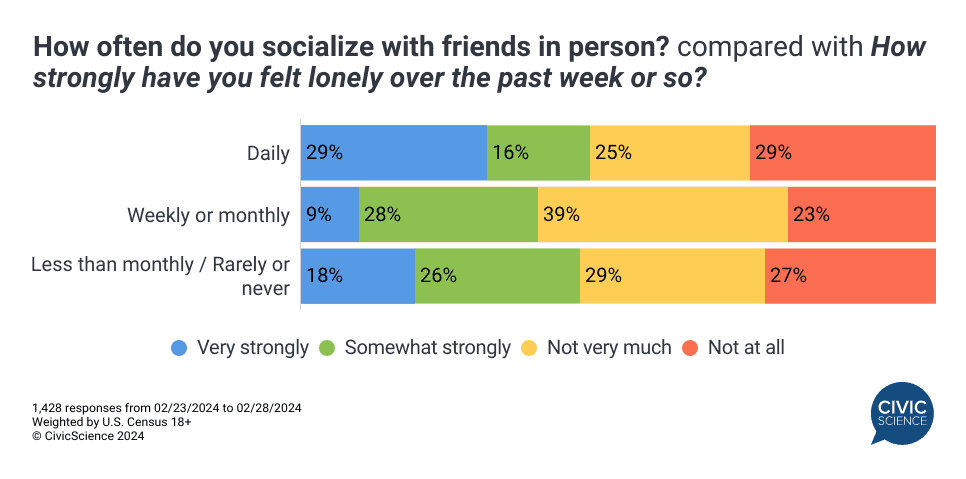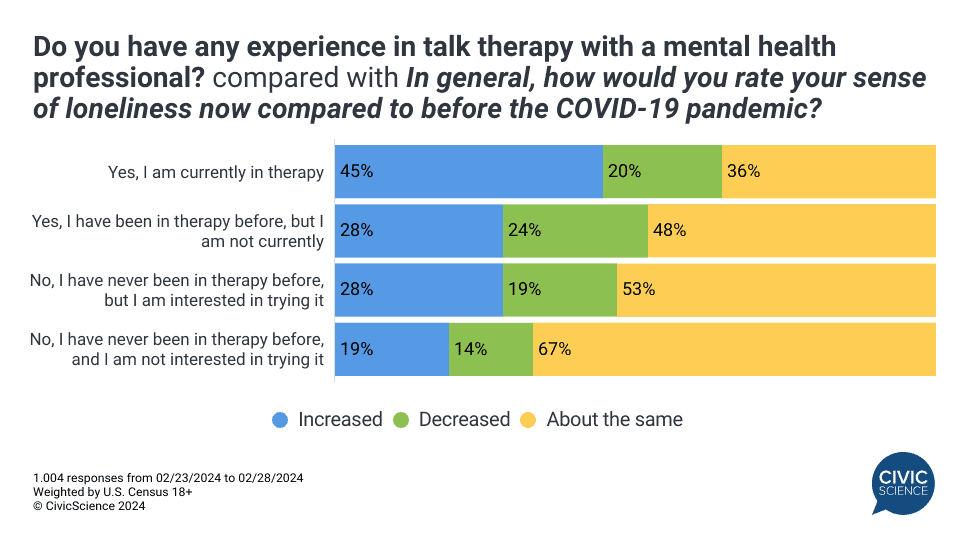Loneliness has been a health concern for years. Even before the mandated isolation brought on by the lockdowns of 2020, Americans had been dealing with the repercussions of 21st century living – which is less and less centered around social connection. What is the current state of loneliness in the U.S., termed an ‘epidemic’ by the U.S. Surgeon General? And what does increasing nationwide loneliness suggest about the future of Americans’ health and wellness?
The Pandemic’s Impact
As the data show, 26% of U.S. adult respondents say their sense of loneliness has increased for them since before the pandemic, with Gen Z continuing to feel the most lonely. That outweighs the 21% of Americans who say they feel less lonely now (excluding those who are ‘not sure’).

The data speaks for itself. In 2019, 45% of Americans reported that they generally felt either ‘sometimes’ or ‘often’ lonely. That percentage has grown to 48% in 2024, a steady rise.
Join the Conversation: How often do you feel lonely?
Loneliness Is More Than Being Alone
Previous studies have shown that social relationships have suffered due to the COVID-19 pandemic, but may be slowly improving. Despite the increase in loneliness, Americans are in fact socializing with friends more frequently than they were around this time last year, with over 50% of U.S. adults seeing their friends weekly or more. Those who socialize weekly or monthly are the least likely to struggle with loneliness, and yet, those who socialize daily are the most lonely – even more so than those who infrequently or rarely socialize with friends.

Combined with the fact that the data show the highest rates of loneliness among Americans who either live alone or live with 4-5 people, it seems that loneliness is about more than just physical proximity or isolation. Likewise, data also show that hybrid workers – who work jobs that are both remote and in-person – are far more likely than fully remote workers to report strong feelings of loneliness (58% versus 35%).
One of the underlying problems may be that 13% of U.S. adults feel that they can’t talk to anyone about their mental health. So regardless of how often you socialize or how many people you live or work with, this sentiment could pose a clear obstacle to overcoming loneliness and fostering healthy connection.
Help Is Here
Fortunately, all isn’t lost. Those who are currently in talk therapy are also the most likely to have experienced an increase in loneliness since the pandemic. So although the feeling has increased, therapy may be offering one way to manage it.

Exercise may also offer an outlet for Americans to process their emotions. Currently, 51% of those who often feel lonely report that they exercise several times a week.
As the past several years have demonstrated, loneliness – and the opportunity to experience extended periods of isolation – may be here to stay. However, in the midst of this bleak emotional landscape, many Americans are finding healthy ways to cope through therapy and physical exercise. So while the source of loneliness may not be going away anytime soon, there may be hope in managing the impact, after all.
Weigh In: Do you think talk therapy is underutilized?
Looking for more insights like these? The CivicScience InsightStore™ collects more than 4 million consumer survey responses daily. Get in touch to learn how CivicScience solutions can benefit your brand.








